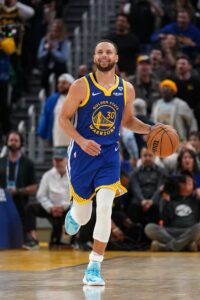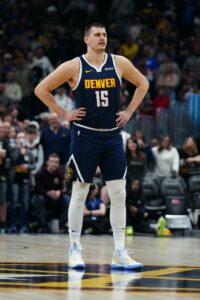The 2022/23 NBA regular season will tip off next month, so we’re getting serious about predictions for the upcoming campaign and continuing an annual Hoops Rumors tradition.
With the help of the lines from a handful of sports betting sites – including Bovada, BetOnline, and Betway – we’re running through the predicted win totals for each of the NBA’s 30 teams, by division. In a series of team-by-team polls, you’ll get the chance to weigh in on whether you think those forecasts are too optimistic or too pessimistic.
In 2021/22, our voters went 16-14 on their over/under picks. Can you top that in ’22/23?
We’ll wrap up our series today with the Northwest division…
Denver Nuggets
- 2021/22 record: 48-34
- Over/under for 2022/23: 51.5 wins
- Major offseason moves:
Minnesota Timberwolves
- 2021/22 record: 46-36
- Over/under for 2022/23: 49.5 wins
- Major offseason moves:
Portland Trail Blazers
- 2021/22 record: 27-55
- Over/under for 2022/23: 40.5 wins
- Major offseason moves:
Utah Jazz
- 2021/22 record: 49-33
- Over/under for 2022/23: 25.5 wins
- Major offseason moves:
- Added: Collin Sexton, Lauri Markkanen, Malik Beasley, Jarred Vanderbilt, Talen Horton-Tucker, Ochai Agbaji, Walker Kessler, Stanley Johnson, Simone Fontecchio, Leandro Bolmaro
- Note: The Jazz are carrying 17 players with guaranteed salaries, so it’s possible not all of these players will make the regular season roster.
- Lost: Rudy Gobert, Donovan Mitchell, Royce O’Neale, Danuel House, Hassan Whiteside, Juancho Hernangomez, Eric Paschall, Trent Forrest
- Added: Collin Sexton, Lauri Markkanen, Malik Beasley, Jarred Vanderbilt, Talen Horton-Tucker, Ochai Agbaji, Walker Kessler, Stanley Johnson, Simone Fontecchio, Leandro Bolmaro
Oklahoma City Thunder
- 2021/22 record: 24-58
- Over/under for 2022/23: 22.5 wins
- Major offseason moves:
- Added: Chet Holmgren, Jalen Williams, Ousmane Dieng, Jaylin Williams
- Note: Holmgren will miss the 2022/23 season due to a right foot injury.
- Lost: Isaiah Roby
- Note: The Thunder are carrying 18 players with fully or partially guaranteed salaries, so they’ll likely part with three more players from last season’s roster.
- Added: Chet Holmgren, Jalen Williams, Ousmane Dieng, Jaylin Williams
Previous voting results:
- Boston Celtics (55.5 wins): Under (56.1%)
- Brooklyn Nets (51.5 wins): Under (64.5%)
- Philadelphia 76ers (50.5 wins): Over (76.1%)
- Toronto Raptors (46.5 wins): Over (65.7%)
- New York Knicks (40.5 wins): Under (63.0%)
- Milwaukee Bucks (52.5 wins): Over (75.5%)
- Cleveland Cavaliers (47.5 wins): Over (73.4%)
- Chicago Bulls (44.5 wins): Over (51.6%)
- Detroit Pistons (28.5 wins): Over (51.6%)
- Indiana Pacers (23.5 wins): Under (62.8%)
- Miami Heat (50.5 wins): Under (56.6%)
- Atlanta Hawks (46.5 wins): Over (53.6%)
- Charlotte Hornets (36.5 wins): Under (63.0%)
- Washington Wizards (35.5 wins): Under (50.8%)
- Orlando Magic (26.5 wins): Over (55.3%)
- Golden State Warriors (53.5 wins): Over (69.2%)
- Phoenix Suns (53.5 wins): Over (60.2%)
- Los Angeles Clippers (52.5 wins): Over (58.0%)
- Los Angeles Lakers (45.5 wins): Under (66.6%)
- Sacramento Kings (34.5 wins): Over (62.0%)
- Memphis Grizzlies (49.5 wins): Over (68.7%)
- Dallas Mavericks (48.5 wins): Over (63.7%)
- New Orleans Pelicans (44.5 wins): Over (61.2%)
- Houston Rockets (24.5 wins): Under (61.8%)
- San Antonio Spurs (23.5 wins): Under (67.5%)
 The Designated Veteran rule allows a player with between seven and nine years of NBA experience – who would normally qualify for a starting salary worth 30% of the NBA’s salary cap on a new free agent contract or extension – to become eligible for a salary worth up to 35% of the cap if he meets one of the following requirements:
The Designated Veteran rule allows a player with between seven and nine years of NBA experience – who would normally qualify for a starting salary worth 30% of the NBA’s salary cap on a new free agent contract or extension – to become eligible for a salary worth up to 35% of the cap if he meets one of the following requirements:
